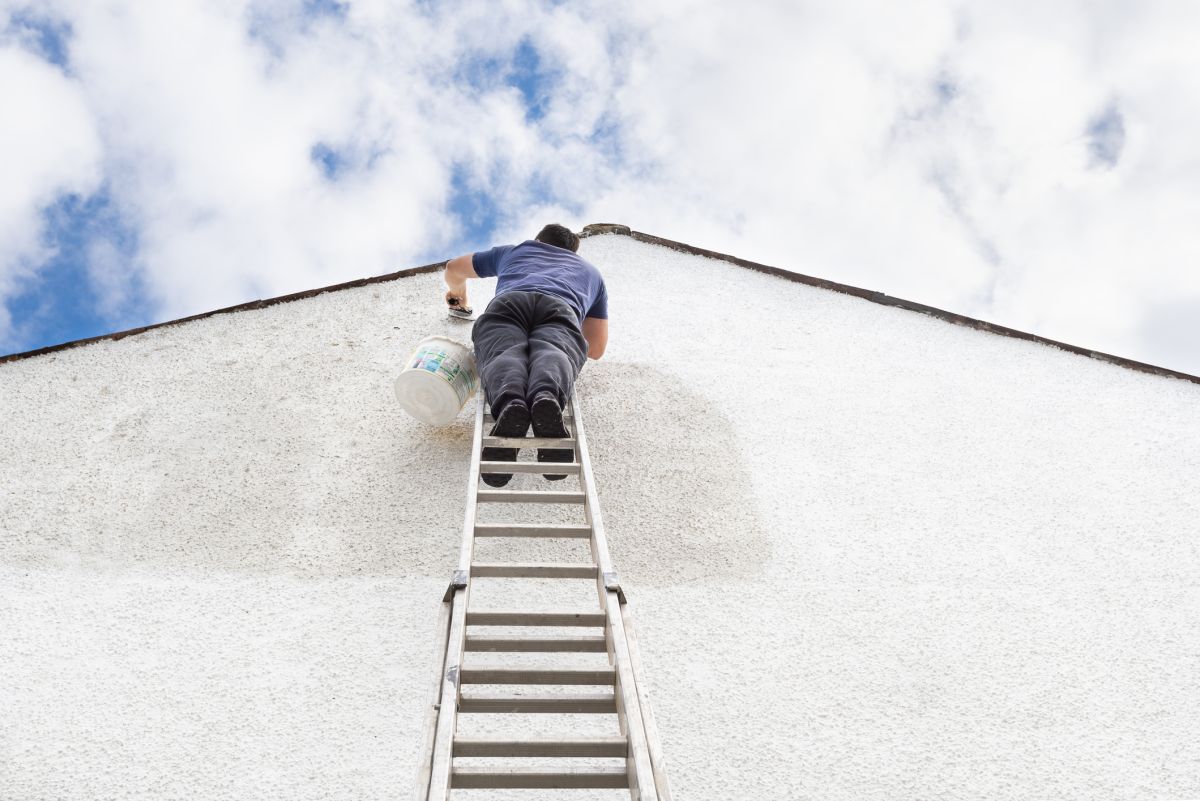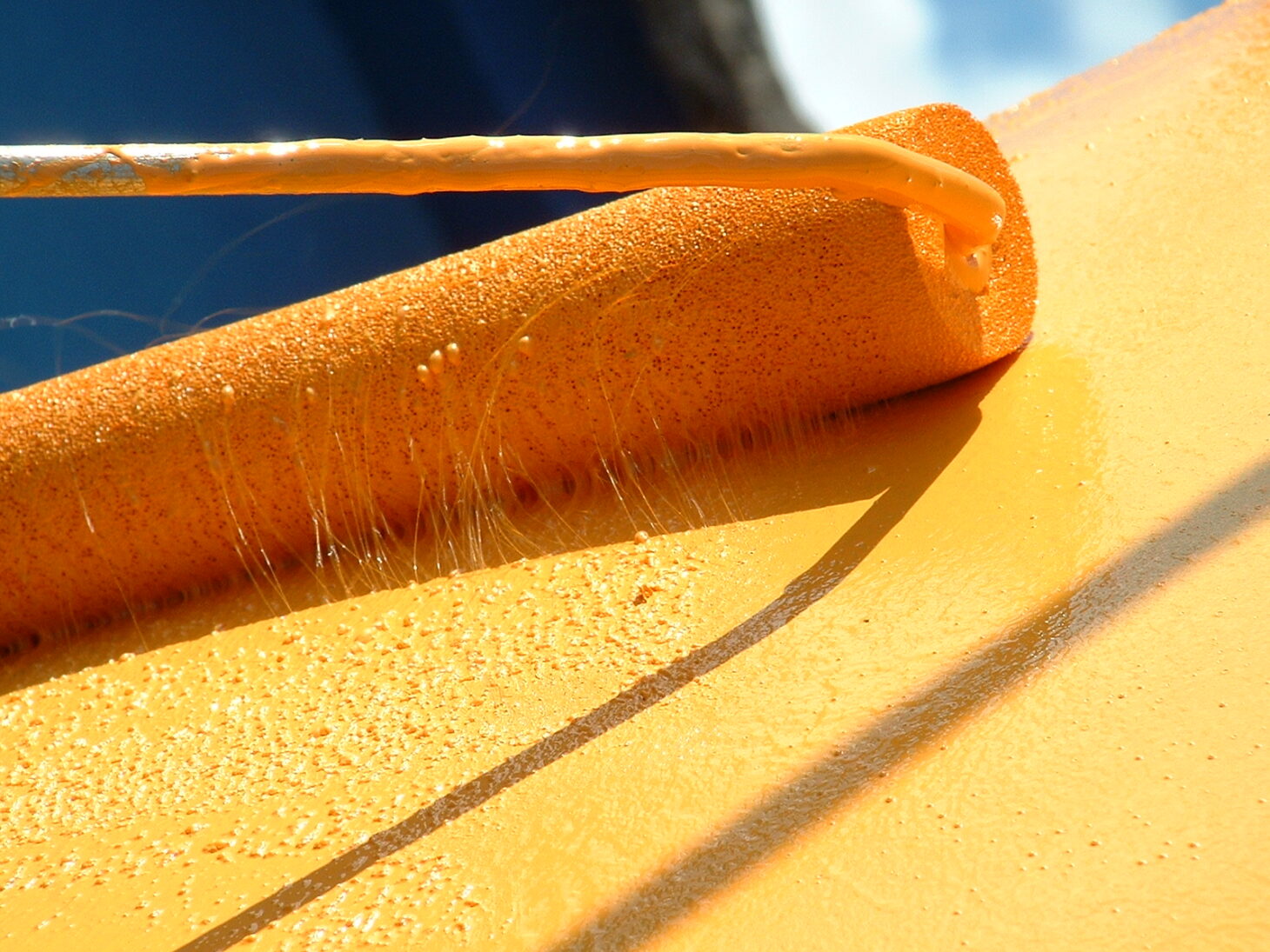Table of Content
Barrier painting or internal blocking is commonly used as anti-mould paint for moist walls, but is it effective?
Well, a big NO!
Masonry paint can not cure when the walls are already damp and wet.
Remember that damp originates from the outside, so even if you’ve put up a barrier in the shape of anti-damp paint on the inner walls, the damp is still there, just underneath the barrier you have painted on!
And while it’s stuck inside your walls and won’t leave, it’s becoming worse.

painting gable end of house with ladder
Your walls are moist.
Damp walls may begin to rust the wall ties, causing the outer leaf of the home to collapse over time.
Dry ROT is caused by wooden boards and joists, notably wooden lintels in older structures.
Water will accumulate in the microscopic holes and spaces in the bricks, which will be frozen and grow when winter arrives, generating numerous fissure cracks across the whole structure of the house, potentially leading to dysfunctionality.
Today’s market has a wide range of moisture-proof paints to choose from: Some damp resistant paints, almost entirely interior paints, are appropriate for the semi-competent DIY enthusiast and can be used safely if used according to the paint manufacturer’s recommendations.
However, they will not eliminate the moisture in your home.
Is it possible to use damp-proof paint?
The answer is a resounding NO. Masonry Paint or Cellar Paint are other names for these paints.
Damp-proof paint is a type of paint that traps moisture in a building’s structure. The wetter the system beneath you becomes, the more you start to put on. As a gas, water can enter the establishment even through the coatings of the paint. It can’t get out as soon as it cools down and condenses to turn into liquid water since the trapping is done by the damp proof paint. It’s essentially a single-way barrier, allowing water to enter as a gas but retaining it once it cools.
We routinely attend houses that are extremely wet and damp and are covered in multiple layers of damp proof paint. Every time we take the dreaded material off, the wall underneath is dripping wet. The wall begins to dry as soon as the paint is removed.
Don’t be fooled by buying damp proof paint. If you have an issue with a wall, or think you do, do some study and adequately identify the problem; you’ll always uncover the genuine treatment – and cause. And the answer will never include damp proof paint; if you want a coloured finish, limewash will suffice, but it must be suitably breathable. Paint firms sell ‘micro porous’ paint – don’t be fooled – it isn’t, and it doesn’t breathe so that it won’t let water out. Limewash is the only genuine breathable paint.
It’s the same thing as masonry paint. It’s ineffective since it’s not breathable and traps water inside the structure. Don’t be fooled into thinking that ‘breathable’ or ‘washable’ emulsions are the only options; all modern paints contain polymers and are not breathable.
Are there any wall coverings that are resistant to water?
Specialist anti-damp wall coatings or damp proof paint are employed mainly by wall coatings firms and comprise a mixture of chemicals that can only be safely applied by someone with the appropriate instruments and knowledge.
Pebbledash replacement, brickwork joint points, re-rendering, removing and replacing damaged pebbledash, repairing hollow render, and a variety of other activities to make the house’s exterior walls solid and suitable for the purpose are all standard repairs.

damp proof paint
Other damp-proofing techniques, however, without the use of paint
If you really want to damp proof your walls of the home but don’t want to use waterproof paint or coating, you have several options: a clear coat system.
The system is sprayed on, and the capillary retraction, which causes a moist wall to soak in water like a sponge, soaks up the chemical instead, crystallising inside the wall rather than outside and preventing dampness from entering.
As you can see, combating moisture from the inside is ineffective because the damp will find another way in through another area of the wall.
The ONLY method to get rid of moisture is to have work done on the house’s EXTERIOR!
Here are some top alternatives to damp proofing a wall:
- Damp-proof membrane: High-Density Polyethylene (HDPE), which is impermeable to moisture and salts, is used to make damp proof membranes. After the cause of the dampness is rectified, they are fastened to inside walls. The membrane’s surface includes an egg box-like contour, which forms an air gap allowing the moisture from the wall to evaporate. These membranes are a wonderful way to damp proof walls since they are simple to install and adaptable. Because of their elasticity, they can deal with structural movement, ensuring that your damp proofing will last for decades.
- Tanking Slurry for Damp Proofing Brick Walls: Hacking back to the original brickwork and applying a tanking slurry is another method of damp proofing concrete, brick, and masonry walls. These Slurries are cement-based coatings that are waterproof and are placed on masonry using a brush to form a completely waterproof surface. They can endure a lot of water pressure. Although they are most commonly used for basement waterproofing, they also perform effectively in preventing moisture above ground. Just apply the Salt Inhibitor primer once the surface has been prepped. Then, four to eight hours apart, apply two coats of tanking to the wall before finishing with renovating plaster or a cement and sand render. This will result in a waterproof covering that is entirely bonded.
Conclusion
A damp-proof course is commonly installed in the construction of most structures. However, if you see damp areas on your lower walls, the course may need to be replaced. This is a time-consuming task that must be completed correctly. As a result, it’s preferable to hire an expert to assess the damage and, if necessary, replace the damp-proof course.
During this season, make sure to keep your home well-ventilated. Take immediate action to eradicate any fungus or mould that has grown on your walls as a result of the rain, as their presence might cause respiratory problems. To avoid wet walls, see a professional as soon as you notice extra moisture or severe fractures in your walls.

